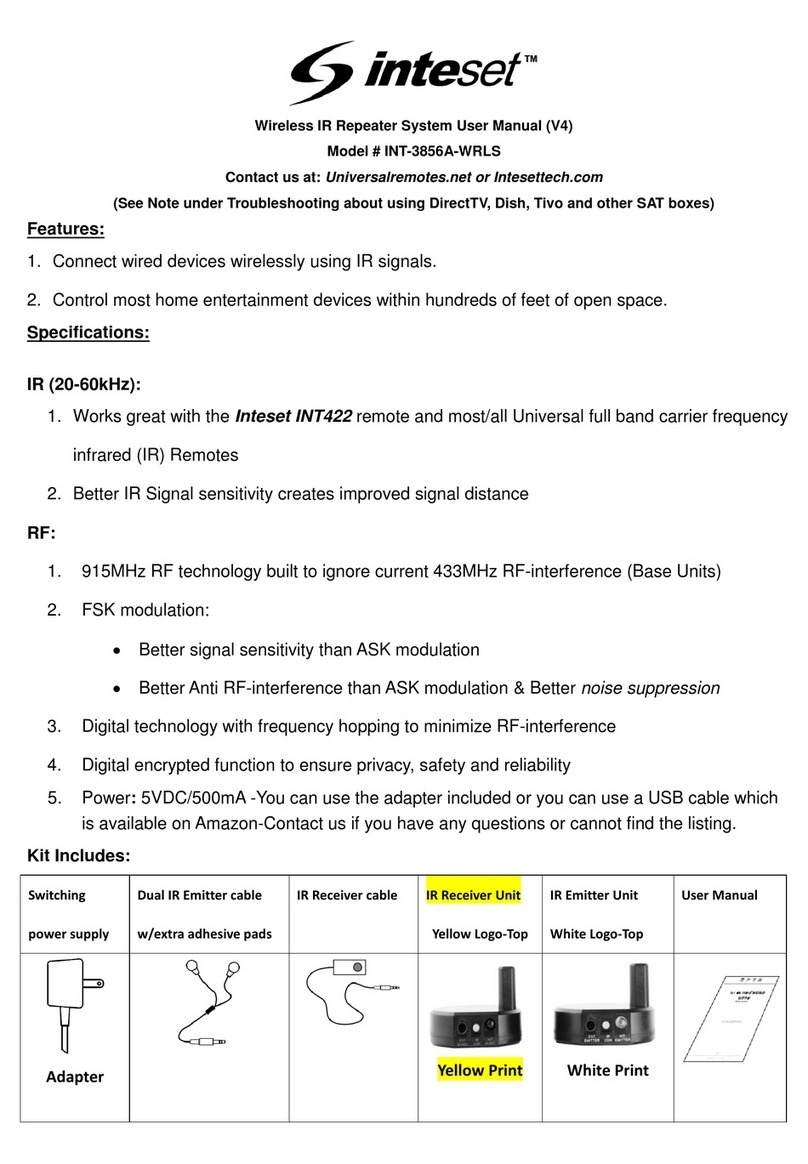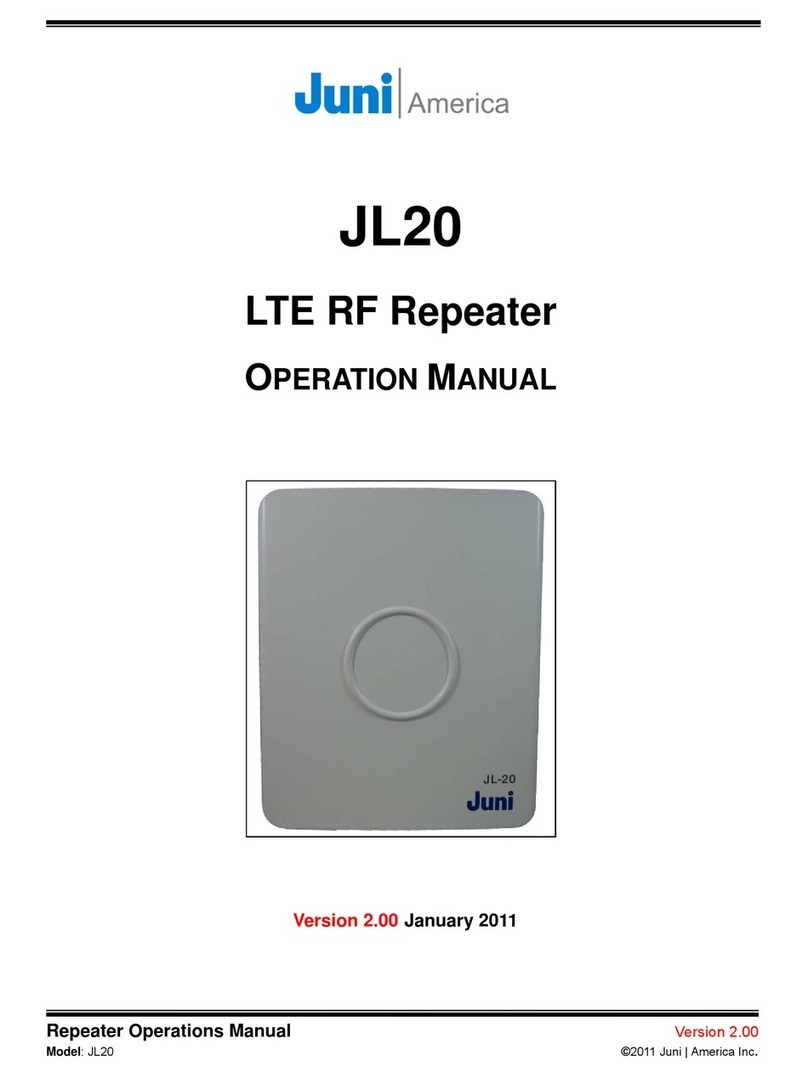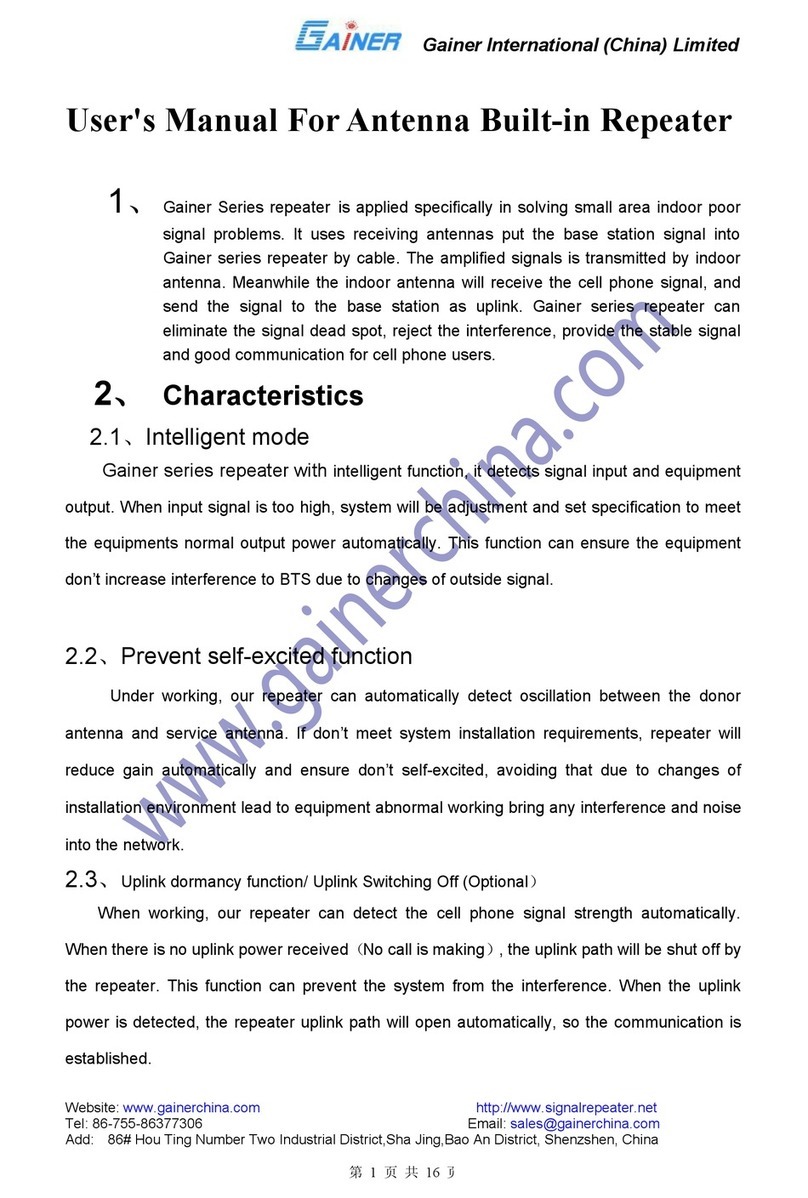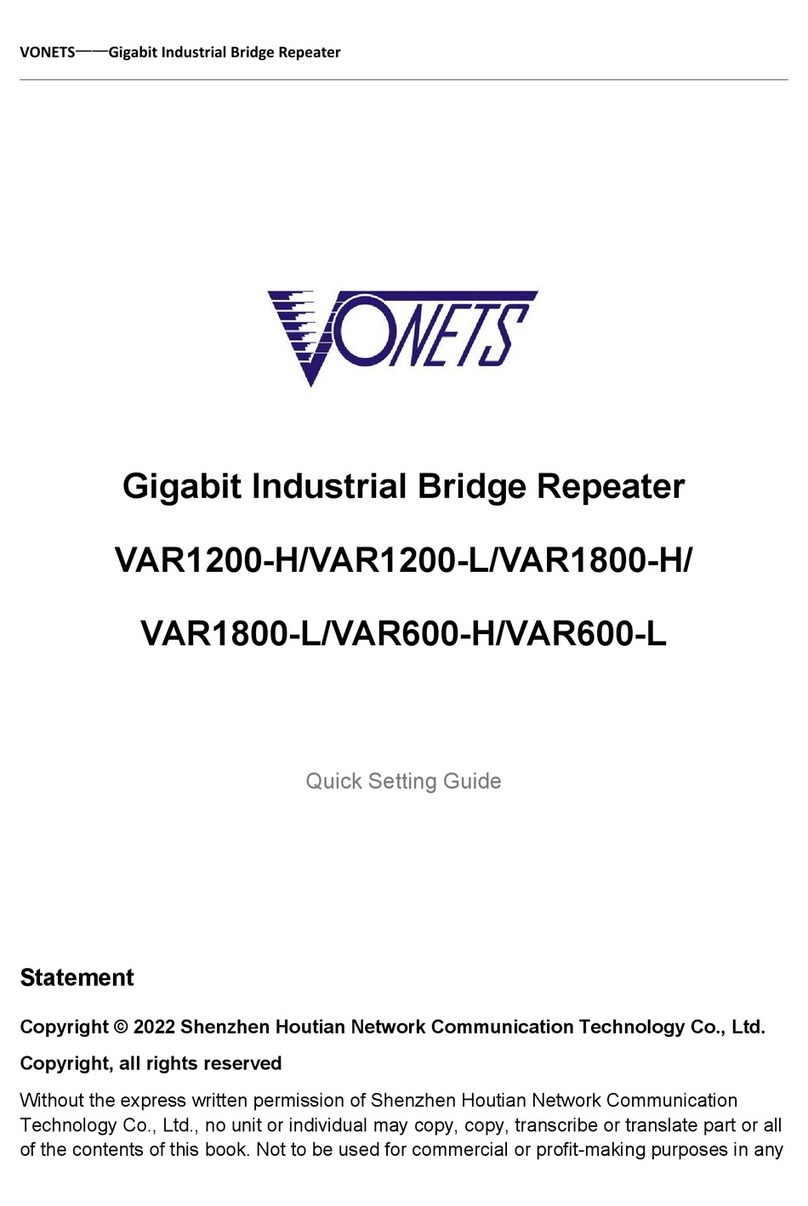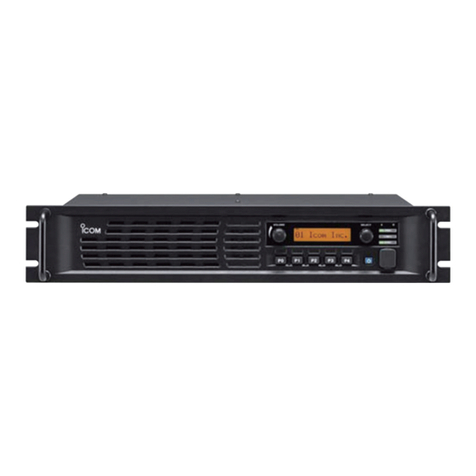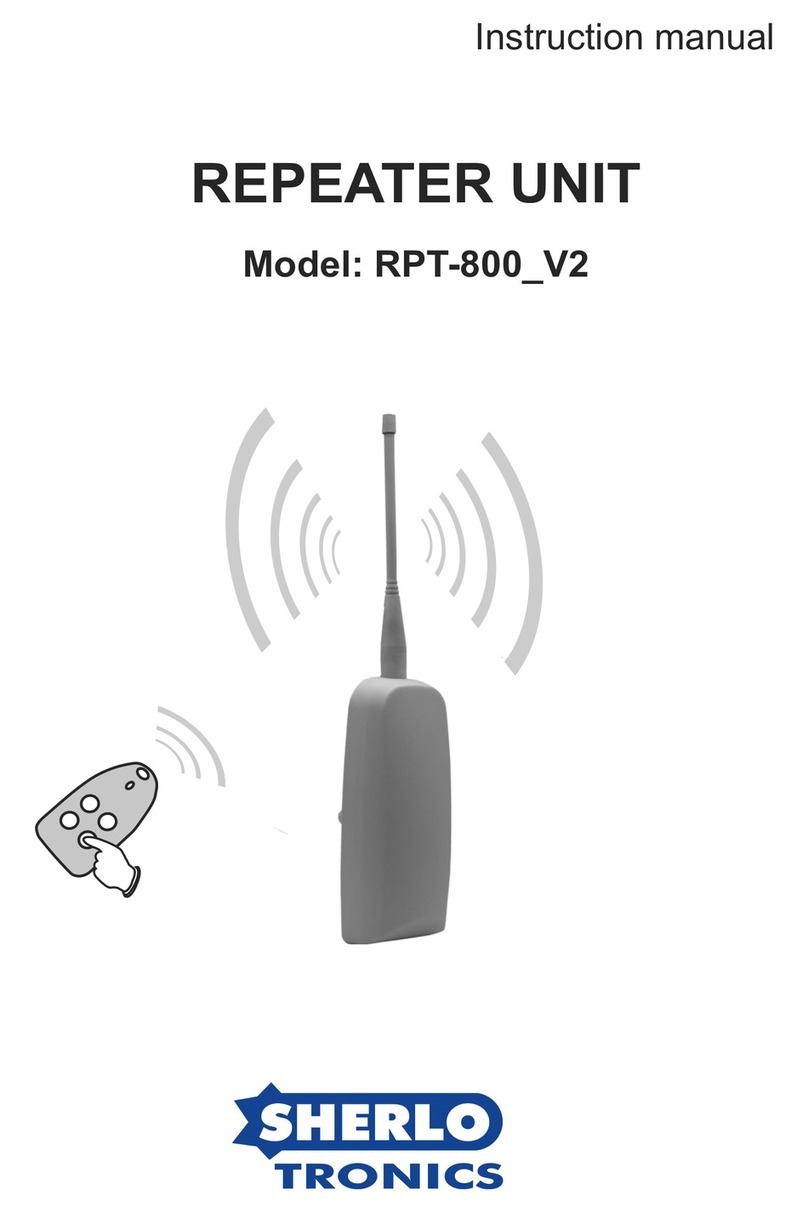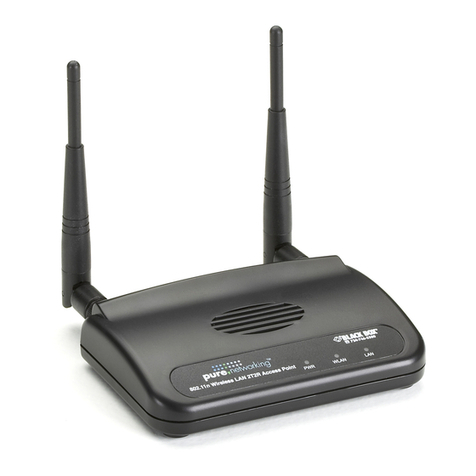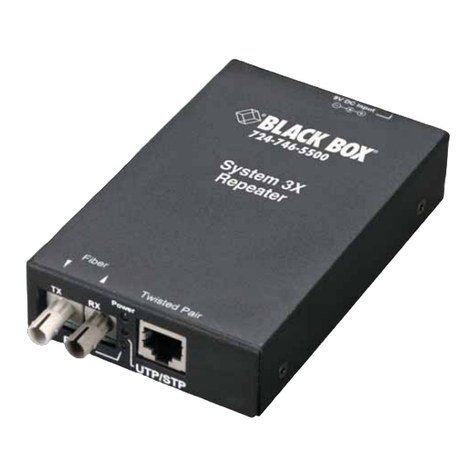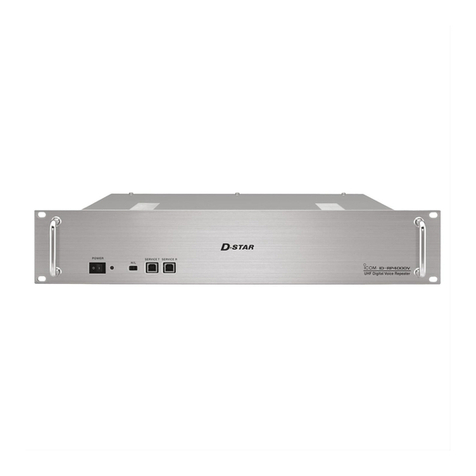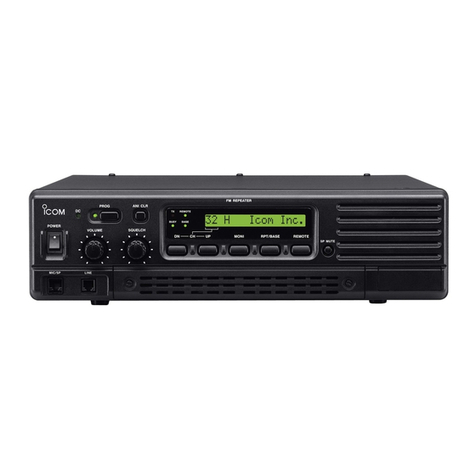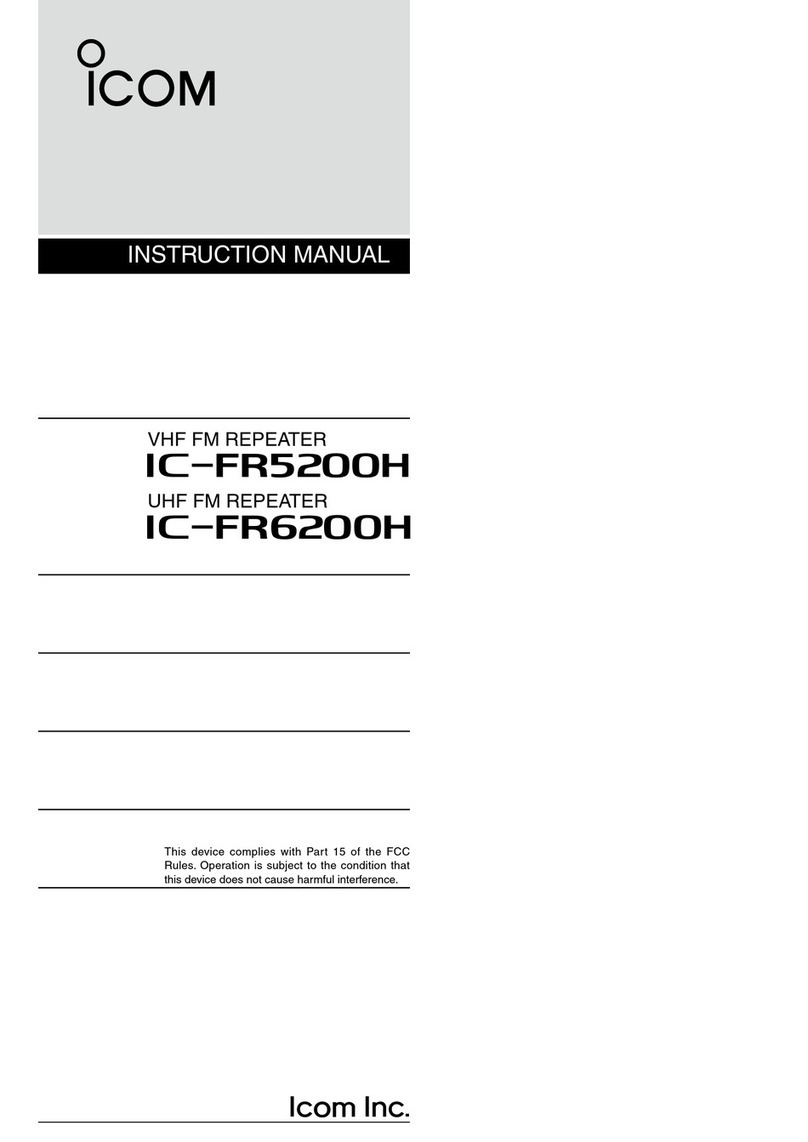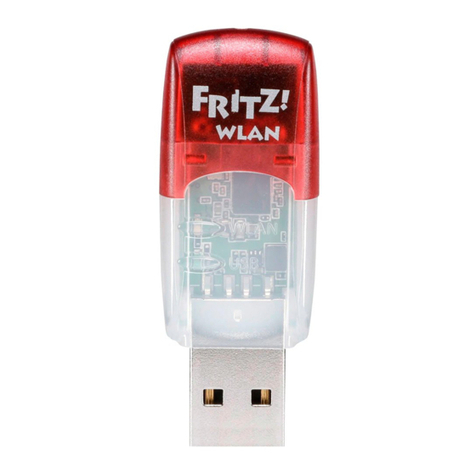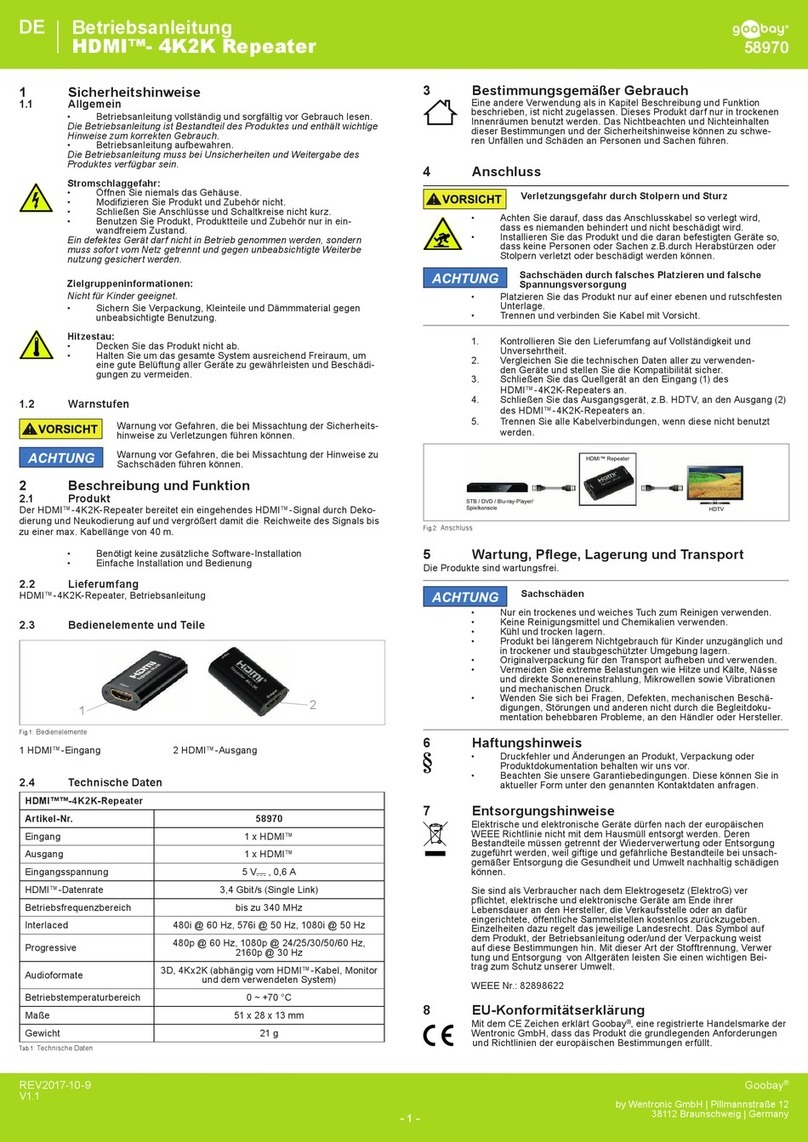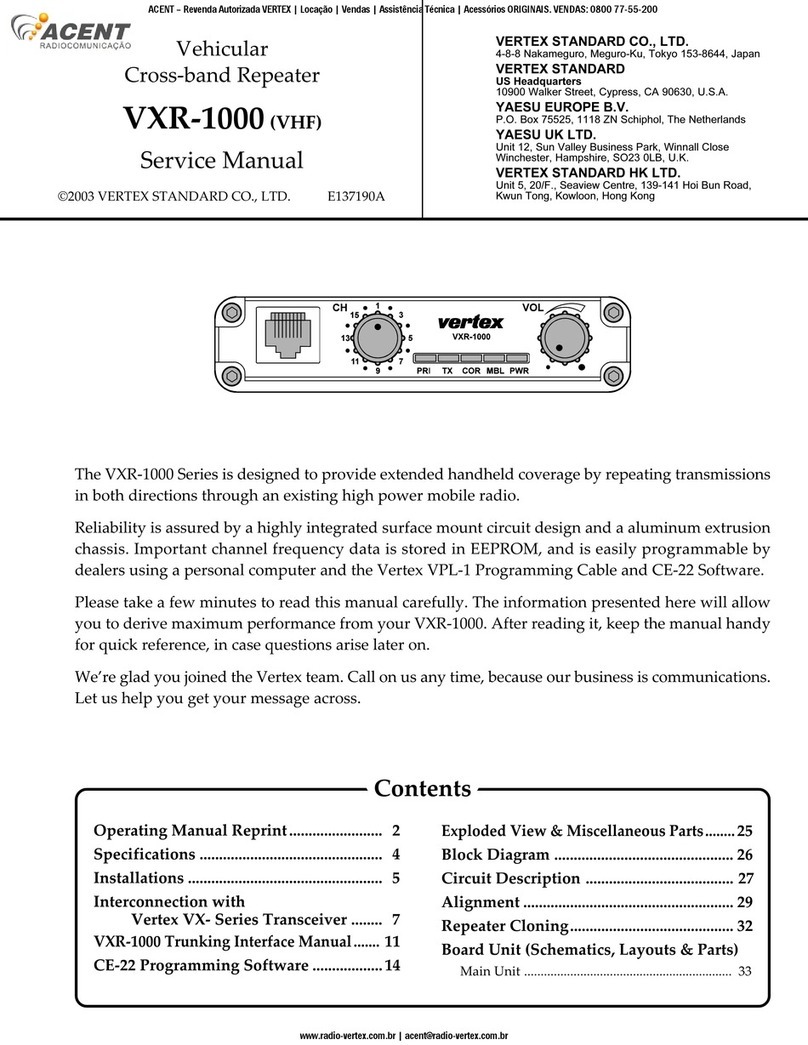esera automation 11318 User manual

Art. No. 11318
All rights reserved. Reproduction as well as electronic duplication of this user guide, complete or in part, requires the written consent of
ESERA GmbH. Errors and technical modification subject to change. ESERA GmbH 2021
www.esera.de 11318 V1.0 R1.1 Repeater Manual Page 1 of 7
User Guide
1-Wire Repeater V2
Improvement of system reliability
Extension and Enlargement of existing
1-Wire Networks
Regenerating the signal quality
Several Repeaters per 1-Wire Network can be
used parallel and in series
DIN rail housing for control cabinet installation
No additional power supply necessary
No software necessary
Simple mounting
Note
Before you start installing the unit and put it into operation, read this operating manual carefully to
the end, especially the section on safety instructions.

All rights reserved. Reproduction as well as electronic duplication of this user guide, complete or in part, requires the written consent of
ESERA GmbH. Errors and technical modification subject to change. ESERA GmbH 2021
www.esera.de 11318 V1.0 R1.1 Repeater Manual Page 2 of 7
1 Product description
The Repeater is used to amplify or regenerate data signals in 1-Wire Networks.
By using the Repeater, a 1-Wire Network can be extended and a significant increase in network stability can
be achieved. Particularly recommended for networks with a "star structure".
The Repeater is simply connected to a 1-Wire cable. No software is necessary.
It supports all types of 1-Wire Masters, such as USB Adapters, 1-Wire Bus couplers, 1-Wire Controllers or
solutions with microcontrollers with 5 V signal level.
No additional power supply or configuration is necessary for the Repeater.
The Repeater is simply connected into the data, ground and 5 V supply line of an existing 1-Wire Network.
One Repeater can be used per bus line. Several Repeaters can be operated in parallel or in series.
The Repeater V2 can be installed at any point within a 1-Wire Bus section.
When operating 1-Wire Networks with many bus participants, long cables or a star-shaped structure, the
signal quality quickly deteriorates significantly, leading to communication problems. The main reason for this is
the high capacitive bus load caused by the cabling, connectors and 1-Wire modules / components.
By using the 1-Wire Repeater, the Bus load for the Bus master (e.g. USB adapter or 1-Wire Bus coupler) is
significantly reduced.
2 Technical Data
1-Wire Module
none
No.of data channels
1 (bidirectional)
Isolation
no galvanic connection between input and output
Data interface
1-Wire Bus (5 V, data and ground)
Input resistance
100k Ohm (clamp 2-3)
Bus termination
/termination
Output resistance 1.5k Ohm (clamp 5-6)
data line against 5 V operating voltage in each case
Operating voltage
5VDC (+/-10%)
Current
consumption
max. 15 mA (module) + output current
Display
LED for power and 1-Wire Data transmission
Connection
screw terminals (up to 2.5qmm cable cross-section)
3 Ambient conditions
Temperature,Operation
-10°C to +60°C
Air humidity
10 - 92% (non condensing)
Dimensions
17 x 90 x 70mm (WxHxD)
Protection class
III
Protection system
IP20
Auto-E-Connect
Support
none
Note
Basic information and tips on the 1-Wire Bus system can be found in the ESERA Online Shop under
1-Wire Basics or please refer to our eBook in the shop under Training/Documentation.

Art. No. 11318
All rights reserved. Reproduction as well as electronic duplication of this user guide, complete or in part, requires the written consent of
ESERA GmbH. Errors and technical modification subject to change. ESERA GmbH 2021
www.esera.de 11318 V1.0 R1.1 Repeater Manual Page 3 of 7
4 Conformity
EN 50090-2-2
EN 61000-4-2, ESD
EN 61000-4-3, HF
EN 61000-4-4, Burst
EN 61000-4-5, Surge
EN 61000-6-1, interference immunity
EN 61000-6-3, Interference radiation
RoHS
5 Connection diagram
Output:
connection top side
4 = GND (ground)
5 = 1-Wire Bus Data (output)
6 = +5 V voltage
Input:
Module bottom side
1 = GND (ground)
2 = 1-Wire Bus Data (input)
3 = +5V voltage
6 Bus extension
The 1-Wire Repeater achieves the highest effect when it is installed in the first 1/4 - 1/3 of a data line. If a
1-Wire network consists of several 1-Wire lines, e.g. one line to the basement and another to the ground floor
of a house, a 1-Wire Repeater can be provided for each 1-Wire line.
6.1 Example Bus extension
In order to be able to bridge a long distance, it is possible to connect several 1-Wire Repeaters in series.
It has been shown in practice that positioning the first repeater after approx. 1/4 - 1/3 and another one after
approx. 2/3 to 3/4 of the cable distance is very effective. A transmission test before final positioning is
recommended.
Note
The module may only be operated at the voltages and under the ambient conditions specified for it. The unit
may be operated in any position.
The modules may only be put into operation by a qualified electrician.
For further information on the operating conditions, see the following instructions under
"Operating conditions".

All rights reserved. Reproduction as well as electronic duplication of this user guide, complete or in part, requires the written consent of
ESERA GmbH. Errors and technical modification subject to change. ESERA GmbH 2021
www.esera.de 11318 V1.0 R1.1 Repeater Manual Page 4 of 7
7 Parallel operation of Bus sections
Several Repeaters can be operated in parallel to reduce the cable distance acting on the Bus master. In
practice, the use of one 1-Wire Repeater per Bus segment has proven to be recommendable.
7.1 Example parallel operation Bus sections
8 Function of the Repeater
The following diagram shows the function of the 1-Wire Repeater.
8.1 Diagram 1-Wire Data transmission
Test condition: Input: 40 m CAT-5 data cable with four 1-Wire sensors
Output: 2 m CAT-5 data cable with one 1-Wire sensor
Kurve 1
(Gelb)
Kurve 2
(Pink)
Input signal, curve 1 (yellow):
If the 1-Wire signal shape deforms too much (curve 1, yellow) due to long cables, many sensors and
connectors (combined as Bus load), the data timing may no longer be maintained. A deteriorating
transmission of the 1-Wire signal is clearly visible. The falling and rising edges no longer have a rectangular
signal shape. In these cases, communication problems with individual sensors may occur. The errors
sometimes only occur sporadically. In the measured 1-Wire test environment, transmission problems occurred
at times without a repeater.
Input: „worn “
1-Wire data signal
Output: „refreshed “
1-Wire data signal.
rectangular signal shape

Art. No. 11318
All rights reserved. Reproduction as well as electronic duplication of this user guide, complete or in part, requires the written consent of
ESERA GmbH. Errors and technical modification subject to change. ESERA GmbH 2021
www.esera.de 11318 V1.0 R1.1 Repeater Manual Page 5 of 7
Output signal, curve 2 (pink):
The output signal shows a rectangular signal shape again. The signal curve is "refreshed" again and within the
required 1-Wire timing.
9 Display LED
The module has two LED displays for power and 1-Wire data transmission.
10 Software / Control
The module does not require any software.
11 1-Wire Network, Cabling in general
The special feature of the 1-Wire system is the "BUS technology". All devices (sensors and actuators) are
operated in parallel on a three-wire line, which is used for both power supply and data communication. The
1-Wire Bus system joins the list of other successful Bus systems such as CAN or Modbus RTU. All of the
installation principles recommended for these are also applicable and apppropriate to 1-Wire.
The maximum size of a 1-Wire Network is determined by various factors. These are mainly:
- Total cable length and cable type
- Number of 1-Wire devices
- Type of cable installation (topology)
- Number and design of the cable connectors (unnecessary connection transitions should be avoided).
All factors in total are summarised and designated as 1-Wire Bus load. Each increase in a factor increases the
total 1-Wire Bus load for the 1-Wire Controller and thus reduces the maximum network size.
Based on our many years of experience and a lot of feedback from customers, the following conservative
recommendation can be made:
- Maximum cable length 50 -120m
- Number of 1-Wire devices no more than 20 -22 pieces
- As linear a topology as possible without T-junctions
The topology in particular plays a major role. If possible, linear topology should be used. The linear topology can
be compared like pearls on a pearl necklace. The data line should be laid from one device to the next without
T-joints.
Furthermore, the type of cable used can also be mentioned here. We recommend for the cabling
CAT5 or CAT6 network cable. It is also possible to use J-Y(St)Y telephone cables and KNX cables. Longer cable
runs are possible with CAT5 versus CAT7 cables.
With twisted pair cables, a longer connection length can be achieved in an undisturbed environment, as the
capacitive bus load is lower. A total length of 50 m and more can be easily achieved without additional measures.
In disturbed, commercial and industrial environments, the cable should always be shielded to increase the
"robustness" or interference sensitivity of the system.
Note
The above statements on 1-Wire are hints and tips and do not describe any product property or represent
any guaranteed product property of the device and the 1-Wire Controllers.
Information on the basics and tips on the 1-Wire Bus system can also be found in the ESERA Online Shop.
under https://www.esera.de/1-wire-grundlagen/

All rights reserved. Reproduction as well as electronic duplication of this user guide, complete or in part, requires the written consent of
ESERA GmbH. Errors and technical modification subject to change. ESERA GmbH 2021
www.esera.de 11318 V1.0 R1.1 Repeater Manual Page 6 of 7
12 Operating conditions
The module may only be operated at the voltages and under the ambient conditions specified for it. The unit
may be operated in any position. The unit is intended for use in dry and dust-free rooms.
If condensation forms, wait at least 2 hours for the unit to acclimatise.
Do not operate the assembly in an environment where flammable gases, vapours or dusts are or may be
present.
13 Assembly
The installation site must be protected from moisture. The unit may only be used in dry indoor rooms and in
protected outdoor areas.
The unit is intended for installation inside a control cabinet as a stationary unit.
14 Disposal note
Do not dispose of the appliance in household waste! Electronic devices must be disposed of
electronic devices must be disposed of at local collection points for
electronic devices via the local collection points for electronic waste!
15 Safety instructions
When using products that come into contact with electrical voltage, the valid VDE regulations must be observed, especially
VDE 0100, VDE 0550/0551, VDE 0700, VDE 0711 and VDE 0860
All final or wiring work must be carried out with the power turned off.
Before opening the device, always unplug or make sure that the unit is disconnected from the mains.
Components, modules or devices may only be put into service if they are mounted in a contact proof housing. During
installation they must not have power applied.
Tools may only be used on devices, components or assemblies when it is certain that the devices are disconnected
from the power supply and electrical charges stored in the components inside the device have been discharged.
Live cables or wires to which the device or an assembly is connected, must always be tested for insulation faults or
breaks.
If an error is detected in the supply line, the device must be immediately taken out of operation until the faulty cable
has been replaced.
When using components or modules it is absolutely necessary to comply with the requirements set out in the
accompanying description specifications for electrical quantities.
If the available description is not clear to the non-commercial end user what the applicable electrical characteristics for
a part or assembly are, how to connect an external circuit, which external components or additional devices can be
connected or which values these external components may have, a qualified electrician must be consulted.
It must be examined generally before the commissioning of a device, whether this device or module is basically
suitable for the application in which it is to be used.
In case of doubt, consultation with experts or the manufacturer of the components used is absolutely necessary.
For operational and connection errors outside of our control, we assume no liability of any kind for any resulting
damage.
Kits should be returned without their housing when not functional with an exact error description and the
accompanying instructions. Without an error description it is not possible to repair. For time-consuming assembly or
disassembly of cases charges will be invoiced.
During installation and handling of components which later have mains potential on their parts, the relevant VDE
regulations must be observed.
Devices that are to be operated at a voltage greater than 35 VDC / 12mA, may only be connected by a qualified
electrician and put into operation.
Commissioning may only be realized if the circuit is built into a contact proof housing.
If measurements with an open housing are unavoidable, for safety reasons an isolating transformer must be installed
upstream or a suitable power supply can be used.
After installing the required tests according to DGUV / regulation 3 (German statutory accident insurance,
https://en.wikipedia.org/wiki/German_Statutory_Accident_Insurance) must be carried out.
16 Warranty
ESERA GmbH guarantees that the goods sold at the time of transfer of risk to be free from material and workmanship
defects and have the contractually assured characteristics. The statutory warranty period of two years begins from date of
invoice. The warranty does not extend to the normal operational wear and normal wear and tear. Customer claims for
damages, for example, for non-performance, fault in contracting, breach of secondary contractual obligations,
consequential damages, damages resulting from unauthorized usage and other legal grounds are excluded. Excepting to
this, ESERA GmbH accepts liability for the absence of a guaranteed quality resulting from intent or gross negligence.
Claims made under the Product Liability Act are not affected.
If defects occur for which ESERA GmbH is responsible, and in the case of replacement goods, the replacement is faulty,
the buyer has the right to have the original purchase price refunded or a reduction of the purchase price. ESERA GmbH
accepts liability neither for the constant and uninterrupted availability of the ESERA GmbH or for technical or electronic
errors in the online offer.

Art. No. 11318
All rights reserved. Reproduction as well as electronic duplication of this user guide, complete or in part, requires the written consent of
ESERA GmbH. Errors and technical modification subject to change. ESERA GmbH 2021
www.esera.de 11318 V1.0 R1.1 Repeater Manual Page 7 of 7
We develop our products further and we reserve the right to make changes and improvements to any of the products
described in this documentation without prior notice. If you need documentation or information about older product
17 Trademarks
All mentioned designations, logos, names and trademarks (including those which are not explicitly marked) are
trademarks, registered trademarks or other copyright or trademarks or titles or legally protected designations of their
respective owners and are hereby expressly recognized as such by us. The mention of these designations, logos, names
and trademarks is made for identification purposes only and does not represent a claim of any kind on the part of
ESERA GmbH on these designations, logos, names and trademarks. Moreover, from their appearance on ESERA GmbH
webpages it cannot be concluded that designations, logos, names and trademarks are free of commercial property rights.
ESERA and Auto-E-Connect are registered trademarks of ESERA GmbH.
Auto-E-Connect is registered by ESERA GmbH as a German and European Patent.
18 Contact
ESERA GmbH
Adelindastrasse 20
87600 Kaufbeuren
GERMANY
Tel.: +49 8341 999 80-0
Fax: +49 8341 999 80-10
www.esera.de/
WEEE-Number: DE30249510
Table of contents
